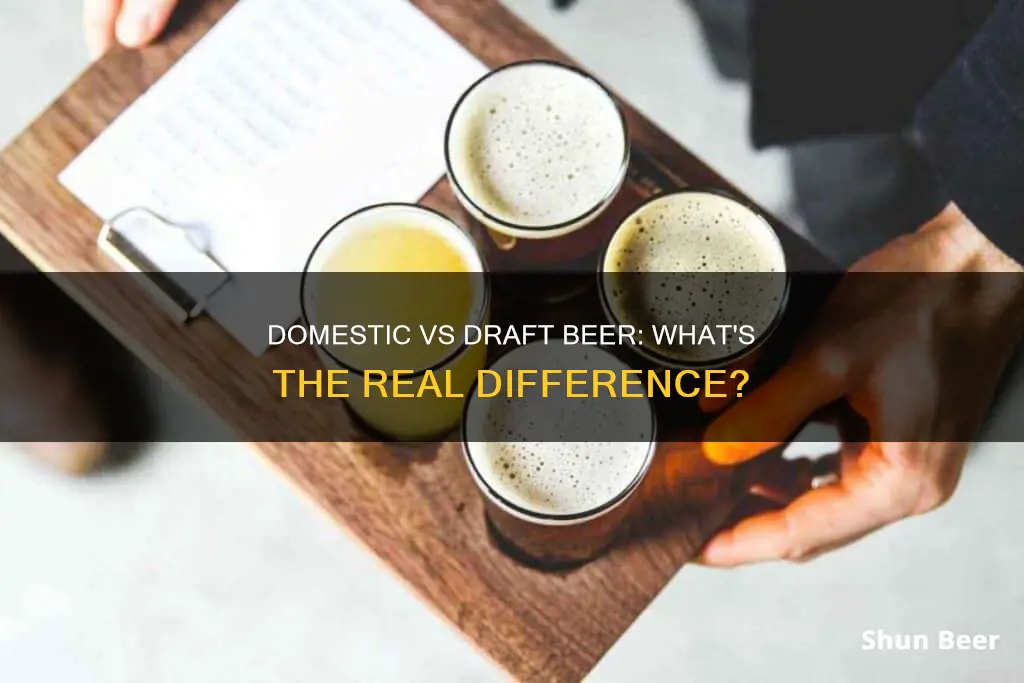
Beer is served in many different ways, and two of the most common are draft and domestic. Draft beer is served directly from a tap or keg and is usually served at a cooler temperature than other beers. The word 'draft' comes from the English word 'draught', which means 'to pull' from a cask with a hand pump. Domestic beer, on the other hand, refers to the country of origin. In the United States, for example, a domestic beer is one that has been brewed in the USA, such as Budweiser or Miller Lite.
Differences between Domestic and Draft Beer
| Characteristics | Values |
|---|---|
| Definition | Domestic beers are produced by large-scale breweries in the USA. Draft beer is served directly from a tap or keg. |
| Taste | Domestic beers have a neutral taste. Draft beer is considered fresher and smoother with more pronounced flavours. |
| Temperature | Draft beer is served at a cooler temperature than bottled or canned beer. |
| Packaging | Domestic beers are typically canned or bottled. Draft beer is packaged in a keg. |
| Availability | Domestic beers are widely available and popular. Draft beer may be more limited in availability. |
| Price | Domestic beers are typically cheaper. |
What You'll Learn

Domestic beers are made in large-scale breweries in the USA
Domestic beers are made in large-scale breweries, which produce a high volume of beer. These breweries often have advanced equipment and processes that allow for efficient and consistent beer production. The large-scale nature of these breweries also enables them to distribute their products widely across the country, making domestic beers easily accessible to consumers.
The large-scale breweries that produce domestic beers typically have well-established brands and a strong market presence. Their beers are often mass-marketed and advertised, contributing to their widespread recognition and popularity. These breweries may also have extensive distribution networks, ensuring their beers are readily available in stores, bars, and restaurants nationwide.
Domestic beers made in these large-scale breweries are known for their consistency in taste and quality. The breweries' ability to maintain consistent brewing processes and standards across large batches of beer contributes to this consistency. This consistency in taste and quality can be appealing to consumers who prefer a familiar and reliable beer-drinking experience.
In addition to their scale and distribution capabilities, large-scale breweries often have the resources to invest in innovative brewing techniques and technologies. This enables them to stay at the forefront of the industry, continuously improving their brewing processes and developing new beer varieties to meet evolving consumer preferences.
Lastly, domestic beers made in large-scale breweries play a significant role in the American beer culture and industry. They are deeply ingrained in the social and recreational aspects of American life, often associated with sports, barbecues, and social gatherings. The widespread consumption and accessibility of domestic beers have also contributed to the growth and economic impact of the beer industry in the USA.
Beer, Lager, and Cider: What Sets Them Apart?
You may want to see also

Draft beer is served from a keg, bottle or can
When ordering beer, it will typically be served from a bottle, can, or draft. Draft beer is a beer that comes directly from a tap or keg. It is usually served at a cooler temperature than bottled or canned beer. The word "draft" comes from the English word "draught", which means "to pull" from a cask with a hand pump.
Draft beer is considered by some to be superior to canned or bottled beer in terms of taste and freshness. This is because draft beer is fresh and has been brewed within the last few weeks, resulting in more pronounced flavours of hops and malt and a smoother texture. In contrast, bottled or canned beer may have been sitting on shelves for weeks or months, leading to a breakdown and fade in flavour.
However, others argue that canned beer tastes better because it has been protected from light and air, which can affect the quality of bottled beer. Bottled beer is also packaged in a way that protects its contents, but it is still exposed to light, air, and temperature changes. Ultimately, the choice between draft, bottled, or canned beer depends on individual taste preferences.
In summary, draft beer is served directly from a keg, tap, or cask and offers a fresh, smooth, and flavourful drinking experience. It is a popular choice for those seeking a beer with more pronounced flavours and a cooler temperature.
Explore Beer's Nuances: Porters vs Lagers
You may want to see also

Draft beer is often served at a cooler temperature
When it comes to beer, there are several types, including draft, craft, domestic, and imported. Each has its own unique characteristics, and understanding these differences can enhance your beer-drinking experience.
Draft beer, also known as draught beer, is served directly from a tap or keg. One of the defining features of draft beer is that it is typically served at a cooler temperature than other beers. This lower temperature is intentional and plays a role in maintaining the freshness of the beer. The cooling temperature helps preserve the flavours of the hops and malt, resulting in a smoother, more flavourful beer.
The freshness of draft beer is further enhanced by the fact that it is typically consumed within a few weeks of brewing. This is in contrast to bottled or canned beers, which may sit on shelves for weeks or even months, leading to a breakdown and fading of flavours over time. The temperature at which bottled and canned beers are stored can also fluctuate, impacting the taste.
The method of serving draft beer directly from the keg or tap also contributes to its unique characteristics. The act of "pulling" the beer, as suggested by the word "draft" or "draught," involves pouring the beer into a glass or mug, creating a lively, bubbly beverage. This method of serving can enhance the flavour and aroma of the beer, contributing to its overall appeal.
The temperature at which draft beer is served is an important factor in the overall experience. By serving it at a cooler temperature, the beer becomes more refreshing and thirst-quenching. This is especially appealing during hot weather or when looking for a beverage to pair with spicy foods. The cooler temperature can also enhance the carbonation and mouthfeel of the beer, creating a crisp, refreshing sensation on the palate.
In summary, draft beer is often served at a cooler temperature, and this temperature plays a significant role in its freshness, flavour, and overall sensory experience. The combination of cooler temperatures, optimal storage, and the method of serving directly from the keg or tap contributes to the unique characteristics of draft beer, making it a popular choice for those seeking a smooth, flavourful, and refreshing beer experience.
Explore the Difference: IPA vs Lager Beer
You may want to see also

Domestic beers are the most popular choice in North America
Some of the leading domestic beer brands in the United States include Budweiser, Miller-Coors, Michelob Ultra Light, Coors, Bud Light, and Miller. These beers are considered "big dog" breweries due to their large-scale production and widespread distribution. They are also commonly used in cooking, such as for grilling brats, which further contributes to their popularity.
The popularity of domestic beers in North America can also be attributed to cultural and social factors. Beer is deeply ingrained in the region's culture and history, with some tracing its roots back to the earliest days of the country. Domestic beers are often associated with social gatherings, sports events, and happy hours, further cementing their place in the social fabric of North America.
Additionally, domestic beers are easily accessible and widely available in stores, bars, and restaurants across the region. This convenience factor plays a significant role in their popularity, as consumers can easily purchase and enjoy these beers without having to search for specialised craft or imported options.
While craft and imported beers have gained traction in recent years, offering unique flavours, higher alcohol content, and local appeal, domestic beers remain the top choice for many North Americans due to their familiarity, affordability, and wide availability.
Discovering Beer's Flavor Profile: A Guide to Taste
You may want to see also

Domestic beers are usually the cheapest option
Domestic beers are often the go-to choice for people who don't have a lot of disposable income to spend on alcohol. They are typically produced in large quantities, which helps to keep the cost low. Additionally, domestic beers are easily accessible and widely available, making them a convenient and affordable option for many.
Some examples of domestic beers in the United States include Budweiser, Miller, Coors, Bud Light, and Michelob Ultra Light. These beers are often featured during happy hour specials at bars, further contributing to their affordability.
While domestic beers may not offer the same unique flavours or local charm as craft beers, they provide a consistent and economical option for beer drinkers. For those who are new to the world of beer or have a limited budget, domestic beers serve as a familiar and cost-effective choice.
In summary, domestic beers are typically the cheapest option due to their large-scale production and widespread availability. They cater to a wide range of consumers, particularly those who prioritise affordability and accessibility in their beverage choices.
Beer vs Pale Ale: What's the Difference?
You may want to see also
Frequently asked questions
Draft beer is served directly from a keg or cask into a glass. It is usually served at a cooler temperature than bottled or canned beer.
Domestic beer is produced by large-scale breweries and is typically made in the USA. It is the most popular choice in North America and is also the cheapest.
Many people believe draft beer tastes better and is fresher due to the temperature and packaging. However, others prefer canned beer as it is protected from light and air.
Canned and bottled beers can be stored for longer than draft beer, which has been brewed within the last few weeks.
Examples of domestic beers include Budweiser, Miller, and Coors.







